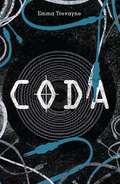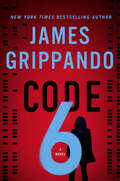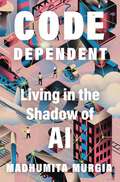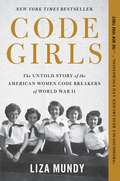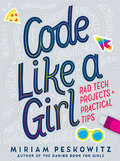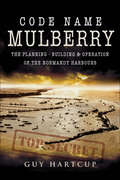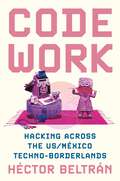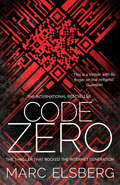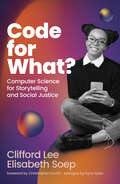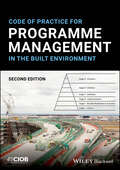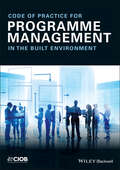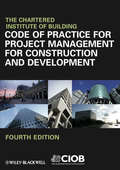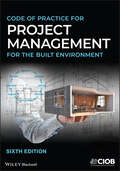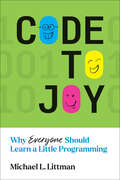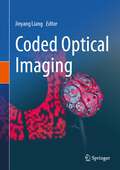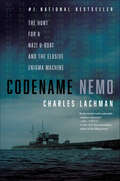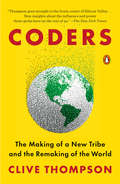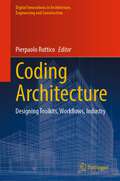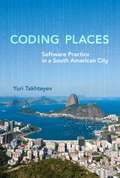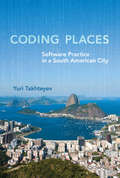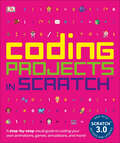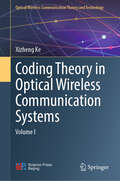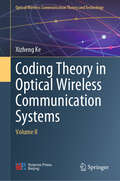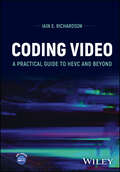- Table View
- List View
Coda
by Emma TrevayneRevolution sings in the air when a teenage boy plays illegal, underground music in a dystopian, Corp-controlled world.
Code 6: A Novel
by James Grippando“A Pandora’s box of demons. . . . High-stakes espionage, family drama, double crosses, noble gestures . . . it’s all here.” — Kirkus Reviews“An ambitious thriller that. . . delivers a deeply satisfying conclusion. . . . Code 6 features some of Grippando's most compelling characters and one of his most intriguing stories.” — BooklistHarper Lee Prize winner and New York Times bestselling author James Grippando returns with a bold new thriller that asks at what price do we open our lives to Big Data.Aspiring playwright, Kate Gamble, is struggling to launch a script she’s been secretly researching her entire life, mostly at the family dinner table. Her father is Christian Gamble, CEO of Buck Technologies, a private data integration company whose clients include the CIA and virtually every counter-terrorism organization in the Western World. Kate’s father adores her, and a play about the dark side of Big Data would be the ultimate betrayal in his eyes. But Kate is compelled to tell this story—not only as an artist exploring the personal information catastrophe that affects us all, but as a daughter trying to understand her mother’s apparent loss of purpose, made even more disturbing by the suicide note she left behind: I did it for Kate.Then Patrick Battle comes back into her life, changing everything she has ever thought about her play, her father, and her mother’s tragic death. Patrick is a childhood friend, but he is now Buck’s golden boy with security clearance to the company’s most sensitive projects. When Buck comes under investigation by the Justice Department and Patrick suddenly goes missing, Kate doesn’t know who to trust. A phone call confirms her worst nightmare: Patrick has been kidnapped, and the ransom demand is “Code 6”—the most secret and potentially dangerous technology her father’s company has ever developed.Kate’s fight to bring Patrick home safely reveals a conspiracy and cover up that may implicate one of the most powerful executives in the tech industry, while the development of Kate’s play unleashes family secrets and the demons behind her mother’s cryptic final note. The two paths converge in explosive fashion, leading to a shocking and terrifying discovery that puts Kate and Patrick in the crosshairs of forces who will stop at nothing to control Code 6.
Code Dependent: Living in the Shadow of AI
by Madhumita MurgiaShortlisted for the Women’s Prize for Non-FictionNamed a best book of the year by Esquire, The Spectator and Publishers WeeklyA riveting story of what it means to be human in a world changed by artificial intelligence, revealing the perils and inequities of our growing reliance on automated decision-makingOn the surface, a British poet, an UberEats courier in Pittsburgh, an Indian doctor, and a Chinese activist in exile have nothing in common. But they are in fact linked by a profound common experience—unexpected encounters with artificial intelligence. In Code Dependent, Murgia shows how automated systems are reshaping our lives all over the world, from technology that marks children as future criminals, to an app that is helping to give diagnoses to a remote tribal community. AI has already infiltrated our day-to-day, through language-generating chatbots like ChatGPT and social media. But it’s also affecting us in more insidious ways. It touches everything from our interpersonal relationships, to our kids’ education, work, finances, public services, and even our human rights.By highlighting the voices of ordinary people in places far removed from the cozy enclave of Silicon Valley, Code Dependent explores the impact of a set of powerful, flawed, and often-exploitative technologies on individuals, communities, and our wider society. Murgia exposes how AI can strip away our collective and individual sense of agency, and shatter our illusion of free will. The ways in which algorithms and their effects are governed over the coming years will profoundly impact us all. Yet we can’t agree on a common path forward. We cannot decide what preferences and morals we want to encode in these entities—or what controls we may want to impose on them. And thus, we are collectively relinquishing our moral authority to machines.In Code Dependent, Murgia not only sheds light on this chilling phenomenon, but also charts a path of resistance. AI is already changing what it means to be human, in ways large and small, and Murgia reveals what could happen if we fail to reclaim our humanity.
Code Girls: The Untold Story of the American Women Code Breakers of World War II
by Liza MundyThe award-winning New York Times bestseller about the American women who secretly served as codebreakers during World War II--a "prodigiously researched and engrossing" (New York Times) book that "shines a light on a hidden chapter of American history" (Denver Post).Recruited by the U.S. Army and Navy from small towns and elite colleges, more than ten thousand women served as codebreakers during World War II. While their brothers and boyfriends took up arms, these women moved to Washington and learned the meticulous work of code-breaking. Their efforts shortened the war, saved countless lives, and gave them access to careers previously denied to them. A strict vow of secrecy nearly erased their efforts from history; now, through dazzling research and interviews with surviving code girls, bestselling author Liza Mundy brings to life this riveting and vital story of American courage, service, and scientific accomplishment.
Code Like a Girl: Rad Tech Projects And Practical Tips
by Miriam PeskowitzWelcome to Code Like a Girl, where you'll get started on the adventure of coding with cool projects and step-by-step tips, from the co-author of the bestselling The Daring Book for Girls.Coding is about creativity, self-expression, and telling your story. It's solving problems and being curious, building things, making the world a better place, and creating a future. It's about you: whoever you are, wherever you're at, whatever you want. Nearly everything you encounter on a screen is made from code. You see, with code you can have an idea and put it into action: it's your voice and your vision. From the outside, tech and code may seem puzzling and mysterious, but when you get through the door and past the first few beginner steps and your code starts to work, it feels like magic. <P><P>In this book, you'll learn how to: <li> Code with Scratch <li> projects like making a dog walk through the park, sending your friend a card, and devising a full-scoring game! <li> Build your own computer--really! <li> Create your own digital fortune-teller, with the Python language. <li> Make your own smartphone gloves. <li> Make light-up bracelets. <li> Code a motion sensor that tells you when someone enters your room. <li> And lots more!
Code Name Mulberry: The Planning, Building & Operation of the Normandy Harbours
by Guy HartcupThis WWII history chronicles the remarkable engineering achievement that kept vital supplies flowing to Allied forces after D-Day. In the planning stages of the Normandy invasion, Allied strategists correctly anticipated that the Germans would deny, either by destruction or dogged defense, the vital Channel ports in the aftermath of D-Day. If the invading armies could not be kept resupplied, Operation Overlord would fail. The only solution was to design, build, transport and install two massive artificial harbors.Code Name Mulberry tells the story of this highly ambitious scheme from the initial planning stage to its successful execution on the field of battle. Told in clear, accessible prose, the historical narrative is amply supported with photographs, diagrams and tables, which vividly demonstrate the scale of this great venture.
Code Work: Hacking across the US/México Techno-Borderlands (Princeton Studies in Culture and Technology #38)
by Héctor BeltránHow Mexican and Latinx hackers apply concepts from coding to their lived experiencesIn Code Work, Héctor Beltrán examines Mexican and Latinx coders&’ personal strategies of self-making as they navigate a transnational economy of tech work. Beltrán shows how these hackers apply concepts from the code worlds to their lived experiences, deploying batches, loose coupling, iterative processing (looping), hacking, prototyping, and full-stack development in their daily social interactions—at home, in the workplace, on the dating scene, and in their understanding of the economy, culture, and geopolitics. Merging ethnographic analysis with systems thinking, he draws on his eight years of research in México and the United States—during which he participated in and observed hackathons, hacker schools, and tech entrepreneurship conferences—to unpack the conundrums faced by workers in a tech economy that stretches from villages in rural México to Silicon Valley.Beltrán chronicles the tension between the transformative promise of hacking—the idea that coding will reconfigure the boundaries of race, ethnicity, class, and gender—and the reality of a neoliberal capitalist economy divided and structured by the US/México border. Young hackers, many of whom approach coding in a spirit of playfulness and exploration, are encouraged to appropriate the discourses of flexibility and self-management even as they remain outside formal employment. Beltrán explores the ways that &“innovative culture&” is seen as central in curing México&’s social ills, showing that when innovation is linked to technological development, other kinds of development are neglected. Beltrán&’s highly original, wide-ranging analysis uniquely connects technology studies, the anthropology of capitalism, and Latinx and Latin American studies.
Code Zero: The unputdownable international bestselling thriller
by Marc ElsbergDISCOVER THE TECHNO THRILLER THAT ROCKED THE INTERNET GENERATIONA Guardian thriller of the month: 'Elsberg is nothing if not prescient'_______ZERO, an anonymous activist, has given the world a warning: stop the tech giants before it’s too late.But is anyone listening? Thousands of teenagers are signing up to Freemee, the biggest new social media site, uploading personal information in exchange for advice on what to eat, how to dress, even how to choose their friends. No-one questions what Freemee is doing with all that data. Until hundreds of users begin to take their lives.What will it take to bring down the Freemee mastermind, and who is up to the job?________‘Worryingly real’ SUNDAY SPORT‘Elsberg is utterly prescient’ GUARDIAN'Sinister and realistic' GLAMOURREADERS ARE BLOWN AWAY BY THIS THRILLER:- On edge, intricate and fast paced. I approached it on recommendation and was blown away- Reads like an actual real life documentary. I wonder how close to the truth it is? Very is my guess.- If you are looking for an engrossing plot as well as plenty of food for thought than I can recommend you give Zero a try.
Code as Creative Medium: A Handbook for Computational Art and Design
by Golan Levin Tega BrainAn essential guide for teaching and learning computational art and design: exercises, assignments, interviews, and more than 170 illustrations of creative work.This book is an essential resource for art educators and practitioners who want to explore code as a creative medium, and serves as a guide for computer scientists transitioning from STEM to STEAM in their syllabi or practice. It provides a collection of classic creative coding prompts and assignments, accompanied by annotated examples of both classic and contemporary projects, and more than 170 illustrations of creative work, and features a set of interviews with leading educators. Picking up where standard programming guides leave off, the authors highlight alternative programming pedagogies suitable for the art- and design-oriented classroom, including teaching approaches, resources, and community support structures.
Code for What?: Computer Science for Storytelling and Social Justice
by Elisabeth Soep Clifford LeeCoding for a purpose: helping young people combine journalism, data, design, and code to make media that makes a difference.Educators are urged to teach &“code for all&”—to make a specialized field accessible for students usually excluded from it. In Code for What? Clifford Lee and Elisabeth Soep instead ask the question, &“code for what?&” What if coding were a justice-driven medium for storytelling rather than a narrow technical skill? What if &“democratizing&” computer science went beyond the usual one-off workshop and empowered youth to create digital products for social impact? Lee and Soep answer these questions with stories of a diverse group of young people in Oakland, California, who combine journalism, data, design, and code to create media that make a difference. These teenage and young adult producers created interactive projects that explored gendered and racialized dress code policies in schools; designed tools for LBGTQ+ youth experiencing discrimination; investigated facial recognition software and what can be done about it; and developed a mobile app to promote mental health through self-awareness and outreach for support, and more, for distribution to audiences that could reach into the millions. Working with educators and media professionals at YR Media, an award-winning organization that helps young people from underserved communities build skills in media, journalism, and the arts, these teens found their own vibrant answers to &“why code?&” They code for insight, connection and community, accountability, creative expression, joy, and hope.
Code of Practice for Programme Management in the Built Environment
by CIOB (The Chartered Institute of Building)CODE OF PRACTICE FOR PROGRAMME MANAGEMENT IN THE BUILT ENVIRONMENT Manage a construction programme from start to finish with this up-to-date guide The maturation and proliferation of project management principles has been one of the most important stories in recent business history. So widely has project management spread throughout the corporate world that it has now given way to a similar discipline, programme management, designed to align, coordinate and manage a number of related projects as a whole. In the construction industry particularly, programme management can deliver benefits that would not have been possible to realise had individual projects been managed independently. Produced by the Chartered Institute of Building (CIOB), the revised Code of Practice for Programme Management in the Built Environment provides a comprehensive overview of the tools required to deliver such benefits, and how they are applied in construction programmes. A natural complement to the CIOB’s popular Code of Practice for Project Management for the Built Environment, it is now fully updated to reflect new insights and best practices. Readers of the second edition of Code of Practice for Programme Management in the Built Environment will find: Theoretical and practical insights derived from research and experience Coverage of setting up programmes successfully so that teams feel confident to deliver the final outcome Guidelines for implementing programme management for the built environment Code of Practice for Programme Management in the Built Environment is ideal for programme management and project management professionals involved in this industry and in particular, contractors and client organisations, as well as for advanced undergraduate and postgraduate students in construction project management and other related disciplines. The Chartered Institute of Building is the world’s largest professional body for construction management and leadership. It has a Royal Charter to promote the science and practice of building and construction for the benefit of society. Members across the world work in the development, conservation, and improvement of the built environment.
Code of Practice for Programme Management: In the Built Environment
by CIOBThe CIOB Code of Practice Programme Management for Construction & Development is intended to complement the popular CIOB Code of Practice for Project Management for Construction and Development, providing practical coverage of general processes and procedures to be followed when managing a construction programme or portfolio of projects. It sets out the necessary requirements for effective and efficient programme management, but is not intended to be a manual of operating procedures for the manager of such programmes.
Code of Practice for Project Management for Construction and Development
by Chartered Institute of BuildingIn 1991 the Chartered Institute of Building initiated a multi-institute task force and a Code of Practice for Project Management for Construction and Development was published in 1992, with second and third editions in 1996 and 2002. Like previous editions, this fourth edition has been extensively updated. The fourth edition includes a range of new illustrations and high profile examples, and features new guidance on: CDM regulations Project planning Change management Project management software Mobile technology The range of procurement options The European perspective Contracts Effective project management involves the assessment and management of risk, and this is a strong theme throughout the Code. The Code of Practice provides an authoritative guide to the principles and practice of construction project management. It will be a key reference source for clients, contractors and professionals, irrespective of the size and nature of the project.
Code of Practice for Project Management for the Built Environment
by CIOB (The Chartered Institute of Building)The latest edition of the gold standard in construction project management references In the newly revised sixth edition of Code of Practice for Project Management for Construction and Development, the Chartered Institute of Building delivers an up-to-date and comprehensive reference to the principles and practice of project management in construction and development. This latest edition covers the new technologies, internationalisation, changing legislation, and productivity and profitability challenges faced by contractors that are driving significant change in the industry. The book demonstrates the application of systematic documentation and quality control to complex construction projects and offers specimen forms, checklists, and documentation that link key principles to practical project management. It is worldwide in scope and widely recognised as the industry standard on the subject. With fresh discussions of quality assurance, global codes and standards, time management, joint ventures, contract compliance, supply chain integration, design digitisation, and much more, the Code of Practice for Project Management for Construction and Development also includes: A thorough introduction to project inception, feasibility analysis, strategy, and the pre-construction process Comprehensive explorations of the construction stage of projects, as well as testing and commissioning, and project completion, handover, and operation Practical discussions of post-completion review A complete glossary and index of essential terms in construction project management Perfect for project management professionals in construction contracting and client organisations, Code of Practice for Project Management for Construction and Development will also earn a place in the libraries of undergraduate and postgraduate students of project management and construction-related subjects.
Code to Joy: Why Everyone Should Learn a Little Programming
by Michael L. LittmanHow we can get more joy from our machines by telling them what our hearts desire.In this informative, accessible, and very funny book, Michael L. Littman inspires readers to learn how to tell machines what to do for us. Rather than give in to the fear that computers will steal our jobs, spy on us and control what we buy and whom we vote for, we can improve our relationship with them just by learning basic programming skills. Our devices will help us, Littman writes, if we can say what we want in a way they can understand.Each chapter of the book focuses on a particular element of what can be said, providing examples of how we use similar communication in our daily interactions with people. Littman offers ways readers can experiment with these ideas right away, using publicly available systems that might also make us more productive as a welcome side effect. Each chapter also reflects on how the use of these programming components can be expedited by machine learning. With humor and teacherly guidance, Code to Joy brings into view a future where programming is like reading—something everyone can learn.
Coded Optical Imaging
by Jinyang LiangThis book provides a comprehensive survey of coded optical imaging. Illustrated with 386 figures, it takes readers from the fundamental concepts and theories to the latest research and applications in this field. It can be used in graduate-level courses in optics and photonics. It can also benefit scientists and engineers in optical imaging, computer graphics, and other related disciplines. This book starts from a brief history of coded optical imaging and key operations in its data acquisition and image reconstruction. It then presents the latest progress in technological development and applications in the areas of biomedicine, materials science, industrial inspection, optical physics, imaging science, information theory, and more. Chapters describe the most representative techniques, exposing readers to key research themes, including: · Optical signal encoding · Image reconstruction techniques · Compressed sensing · Artificial intelligence · Metasurface · Structured light · Lensless imaging · Holography · Tomography · Light-field imaging · Utrafast imaging · Hyperspectral imaging · Polarization imaging · Super-resolution imaging
Codename Nemo: The Hunt for a Nazi U-Boat and the Elusive Enigma Machine
by Charles LachmanThe white-knuckled saga of a maverick captain, nine courageous sailors, and a US Navy task force who achieved the impossible on June 4, 1944--capturing Nazi submarine U-505, its crew, technology, encryption codes, and an Enigma cipher machine. Two days before D-Day--the course of World War II was forever changed. The hunters of the Atlantic Ocean had become the hunted, and US antisubmarine Task Group 22.3 seized a Nazi U-boat, its crew, and all its secrets. Led by a nine-man boarding party and Captain Daniel Gallery, "Operation Nemo" was the first seizure of an enemy warship in battle since the War of 1812, a victory that shortened the duration of the war. But at any moment, the mission could have ended in disaster. Charles Lachman tells this thrilling cat-and-mouse game through the eyes of the men on both sides of Operation Nemo--German U-boaters and American heroes like Lieutenant Albert David ("Mustang"), who led the boarding party that took control of U-505 and became the only sailor to be awarded the Medal of Honor in the Battle of the Atlantic. Three thousand American sailors participated in this extraordinary adventure; nine ordinary American men channeling extraordinary skill and bravery finished the job; and then--like everyone involved--breathed not a word of it until the war was over. In Berlin, the German Kriegsmarine assumed that U-505 had been blown to bits by depth charges, with all hands lost at sea. They were unaware that the U-boat, its Enigma machine, and its Nazi coded messages were now in American hands. They were also unaware that the 59 German sailors captured on the high seas were imprisoned in a POW camp in Ruston, Louisiana, until their release in 1946. A deeply researched, fast-paced World War II narrative for the ages, Charles Lachman's Codename Nemo traces every step of this historic pursuit on the deadly seas.
Coders: The Making of a New Tribe and the Remaking of the World
by Clive ThompsonHello, world.Facebook's algorithms shaping the news. Self-driving cars roaming the streets. Revolution on Twitter and romance on Tinder. We live in a world constructed of code--and coders are the ones who built it for us. From acclaimed tech writer Clive Thompson comes a brilliant anthropological reckoning with the most powerful tribe in the world today, computer programmers, in a book that interrogates who they are, how they think, what qualifies as greatness in their world, and what should give us pause. They are the most quietly influential people on the planet, and Coders shines a light on their culture.In pop culture and media, the people who create the code that rules our world are regularly portrayed in hackneyed, simplified terms, as ciphers in hoodies. Thompson goes far deeper, dramatizing the psychology of the invisible architects of the culture, exploring their passions and their values, as well as their messy history. In nuanced portraits, Coders takes us close to some of the great programmers of our time, including the creators of Facebook's News Feed, Instagram, Google's cutting-edge AI, and more. Speaking to everyone from revered "10X" elites to neophytes, back-end engineers and front-end designers, Thompson explores the distinctive psychology of this vocation--which combines a love of logic, an obsession with efficiency, the joy of puzzle-solving, and a superhuman tolerance for mind-bending frustration. Along the way, Coders thoughtfully ponders the morality and politics of code, including its implications for civic life and the economy. Programmers shape our everyday behavior: When they make something easy to do, we do more of it. When they make it hard or impossible, we do less of it. Thompson wrestles with the major controversies of our era, from the "disruption" fetish of Silicon Valley to the struggle for inclusion by marginalized groups.In his accessible, erudite style, Thompson unpacks the surprising history of the field, beginning with the first coders -- brilliant and pioneering women, who, despite crafting some of the earliest personal computers and programming languages, were later written out of history. Coders introduces modern crypto-hackers fighting for your privacy, AI engineers building eerie new forms of machine cognition, teenage girls losing sleep at 24/7 hackathons, and unemployed Kentucky coal-miners learning a new career. At the same time, the book deftly illustrates how programming has become a marvelous new art form--a source of delight and creativity, not merely danger. To get as close to his subject as possible, Thompson picks up the thread of his own long-abandoned coding skills as he reckons, in his signature, highly personal style, with what superb programming looks like. To understand the world today, we need to understand code and its consequences. With Coders, Thompson gives a definitive look into the heart of the machine.
Coding Architecture: Designing Toolkits, Workflows, Industry (Digital Innovations in Architecture, Engineering and Construction)
by Pierpaolo RutticoThis book provides a clear picture of how computational processes are gradually permeating and innovating the Architecture, Engineering, and Construction sector, contributing to sustainability and aesthetic evolution. It achieves that by gathering a collection of accounts shared by pioneering professionals involved in this innovation, drawing from recent academic studies, ongoing experimental processes conducted in cutting-edge architectural and engineering offices, as well as innovative industrial applications. The covered subjects span a wide range, including artificial intelligence and robotic manufacturing, the metaverse and 3D printing, strategies to counter CO2 consumption through plug-ins, as well as emerging materials and construction techniques. The chapters feature authors who are pioneers and embrace roles like software developers, architects, process engineers, academics, and forward-thinking entrepreneurs. They represent authoritative references within a broader interconnected cultural and technological system; an eclectic system that finds in computational processes the key to addressing the new challenges of contemporary architecture.
Coding Places
by Yuri TakhteyevSoftware development would seem to be a quintessential example of today's Internet-enabled "knowledge work"--a global profession not bound by the constraints of geography. In Coding Places, Yuri Takhteyev looks at the work of software developers who inhabit two contexts: a geographical area--in this case, greater Rio de Janeiro--and a "world of practice," a global system of activities linked by shared meanings and joint practice. The work of the Brazilian developers, Takhteyev discovers, reveals a paradox of the world of software: it is both diffuse and sharply centralized. The world of software revolves around a handful of places--in particular, the San Francisco Bay area--that exercise substantial control over both the material and cultural elements of software production. Takhteyev shows how in this context Brazilian software developers work to find their place in the world of software and to bring its benefits to their city. Takhteyev's study closely examines Lua, an open source programming language developed in Rio but used in such internationally popular products as World of Warcraft and Angry Birds. He shows that Lua had to be separated from its local origins on the periphery in order to achieve success abroad. The developers, Portuguese speakers, used English in much of their work on Lua. By bringing to light the work that peripheral practitioners must do to give software its seeming universality, Takhteyev offers a revealing perspective on the not-so-flat world of globalization.
Coding Places: Software Practice in a South American City (Acting with Technology)
by Yuri TakhteyevAn examination of software practice in Brazil that reveals both the globalization and the localization of software development.Software development would seem to be a quintessential example of today's Internet-enabled “knowledge work”—a global profession not bound by the constraints of geography. In Coding Places, Yuri Takhteyev looks at the work of software developers who inhabit two contexts: a geographical area—in this case, greater Rio de Janeiro—and a “world of practice,” a global system of activities linked by shared meanings and joint practice. The work of the Brazilian developers, Takhteyev discovers, reveals a paradox of the world of software: it is both diffuse and sharply centralized. The world of software revolves around a handful of places—in particular, the San Francisco Bay area—that exercise substantial control over both the material and cultural elements of software production. Takhteyev shows how in this context Brazilian software developers work to find their place in the world of software and to bring its benefits to their city.Takhteyev's study closely examines Lua, an open source programming language developed in Rio but used in such internationally popular products as World of Warcraft and Angry Birds. He shows that Lua had to be separated from its local origins on the periphery in order to achieve success abroad. The developers, Portuguese speakers, used English in much of their work on Lua. By bringing to light the work that peripheral practitioners must do to give software its seeming universality, Takhteyev offers a revealing perspective on the not-so-flat world of globalization.
Coding Projects in Scratch: A Step-by-Step Visual Guide to Coding Your Own Animations, Games, Simulations, a (DK Help Your Kids)
by Jon WoodcockA perfect introduction to coding for young minds! This updated step-by-step visual guide teaches children to create their own projects using Scratch 3.0.Suitable for complete beginners, this educational book for kids gives readers a solid understanding of programming. Teach them to create their own projects from scratch, preparing them for more complex programming languages like Python.Techy kids will familiarize themselves with Scratch 3.0 using this beginner's guide to scratch coding. Difficult coding concepts become fun and easy to understand, as budding programmers build their own projects using the latest release of the world's most popular programming language for beginners.Make a Dino Dance Party or create your own electronic birthday cards for friends and family. Build games, simulations, and mind-bending graphics as you discover the awesome things computer programmers can do with Scratch 3.0. This second edition of Coding Projects in Scratch uses a visual step-by-step approach to split complicated code into manageable, easy-to-digest chunks. Even the most impressive projects become possible. This book is an impressive guide that is perfect for anyone who wants to learn to code. Follow Simple Steps, Improve Your Skills & Share Your Creations!Follow the simple steps to become an expert coder using the latest version of the popular programming language Scratch 3.0 in this new edition. Create mind-bending illusions, crazy animations, and interactive artwork with this amazing collection of Scratch projects. Suitable for beginners and experts alike, this fabulous introduction to programming for kids has everything you need to learn how to code. You'll improve your coding skills and learn to create and customize your own projects, then you can share your games online and challenge friends and family to beat each other's scores! What's inside this kids' coding book? - Simulations, mind-benders, music, and sounds- Algorithms, virtual snow, and interactive features- Different devices, operating systems, programming languages and moreComputer coding teaches kids how to think creatively, work collaboratively, and reason systematically, and is quickly becoming a necessary and sought-after skill. DK's computer coding books for kids are full of fun exercises with step-by-step guidance, making them the perfect introductory tools for building vital skills in computer programming. Coding Projects in Scratch is one of three brilliant coding books for kids. Add Coding Games in Scratch and Coding Projects in Python to your collection.
Coding Theory in Optical Wireless Communication Systems: Volume I (Optical Wireless Communication Theory and Technology)
by Xizheng KeThis book focuses on optical-wireless communication systems. It summarizes the author's optical-wireless communication coding work while carrying out pertinent scientific research programs. The primary topics covered in the book are channel coding, coding modulation, error control (channel coding), and channel equalization. The author's mathematical analysis and experimental studies on the key theoretical issues are discussed in the book. One of the book's outstanding aspects is its thorough and methodical discussion of practical optical-wireless communication challenges. This makes the book especially appealing to readers who are eager to learn about applicable solutions in this area. Researchers, engineers, and graduate students in the subject of telecommunications can all profit from the book. It is appropriate for senior undergraduates, lecturers at colleges and universities, graduate students, and engineering and technical workers involved in optical communication.
Coding Theory in Optical Wireless Communication Systems: Volume II (Optical Wireless Communication Theory and Technology)
by Xizheng KeThis book focuses on optical-wireless communication systems. It summarizes the author's optical-wireless communication coding work while carrying out pertinent scientific research programs. The primary topics covered in the book are channel coding, coding modulation, error control (channel coding), and channel equalization. The author's mathematical analysis and experimental studies on the key theoretical issues are discussed in the book. One of the book's outstanding aspects is its thorough and methodical discussion of practical optical-wireless communication challenges. This makes the book especially appealing to readers who are eager to learn about applicable solutions in this area. Researchers, engineers, and graduate students in the subject of telecommunications can all profit from the book. It is appropriate for senior undergraduates, lecturers at colleges and universities, graduate students, and engineering and technical workers involved in optical communication.
Coding Video: A Practical Guide to HEVC and Beyond
by Iain E. RichardsonA fully up-to-date guide to transformative consumer technologies Video compression – or video coding – has been at the centre of a revolution in the way video is produced, delivered, and consumed. It has made the switch from analogue to digital video possible and has enabled fundamental shifts in the way we now watch video. New video compression standards, together with adaptive streaming protocols, are used to deliver high-quality video to homes and workplaces around the world. Coding Video provides a practical and comprehensive guide to the new landscape of video coding and video streaming. This book explains the core technologies with a wealth of practical examples and illustrations, covers key standards such as H.265/HEVC and includes an introduction to the new H.266/VVC standard. Coding Video will appeal to engineers, application developers, product designers and digital video professionals, as well as to graduate students and researchers in Engineering, Computer Science and related subjects.
